German Wwii Planes Usa Drawing Easy
Fotosearch // Getty Images
xxx iconic posters from Globe War II
Propaganda tin can be a powerful weapon, capable of arousing passions, unifying communities, stirring up fear, or irresolute minds in ways no bullet or bomb can do. During Globe War Ii, Centrolineal and Centrality forces used propaganda posters to spread their letters effectually the world.
Stacker searched Getty Archives to find 30 iconic posters from Earth War II that highlight their power and enduring style. They hail from the United States, Great Britain, the Soviet Marriage, Federal republic of germany, Japan, Italy, and Vichy French republic. Some of the posters fueled patriotism, faith in the nation, and a belief in the righteousness of the state of war effort to protect national values and virtues.
Many aimed to boost morale and deliver a bulletin of shared sacrifice. Duty meant scraping together money to invest in a Us state of war bond or digging a victory garden to feed the family. Every citizen had a job to do.
War could be glorified, with posters showing might and musculus as well as confidence and courage. Soldiers were handsome and fearless, guns were sturdy, and legions of airplanes overhead were formidable. But many were dark reminders of battlefield losses, sinister images of a lurking enemy, or the perils of careless talk or a slit of lite breaching a blackout. Some reached out to particular audiences such as women, encouraging them to step out and test out new roles. Those invitations to change would marker the dawn of modernistic feminism. More than a few had messages that are familiar and popular today, whether they are calls to conserve fuel, travel lightly, or grow nutrient locally on rooftops and in empty lots.
Propaganda posters from all sides were an extraordinary art form that used basic colors and simple words to reach the broadest audition.
The icons survive. Uncle Sam and Rosie the Riveter are notwithstanding employed today. The works remain stirring and powerful, even as nosotros may hope the brutality and cruelty of such a war remain a thing of the by.
You lot may also like: How communities are dealing with invasive species across the Usa
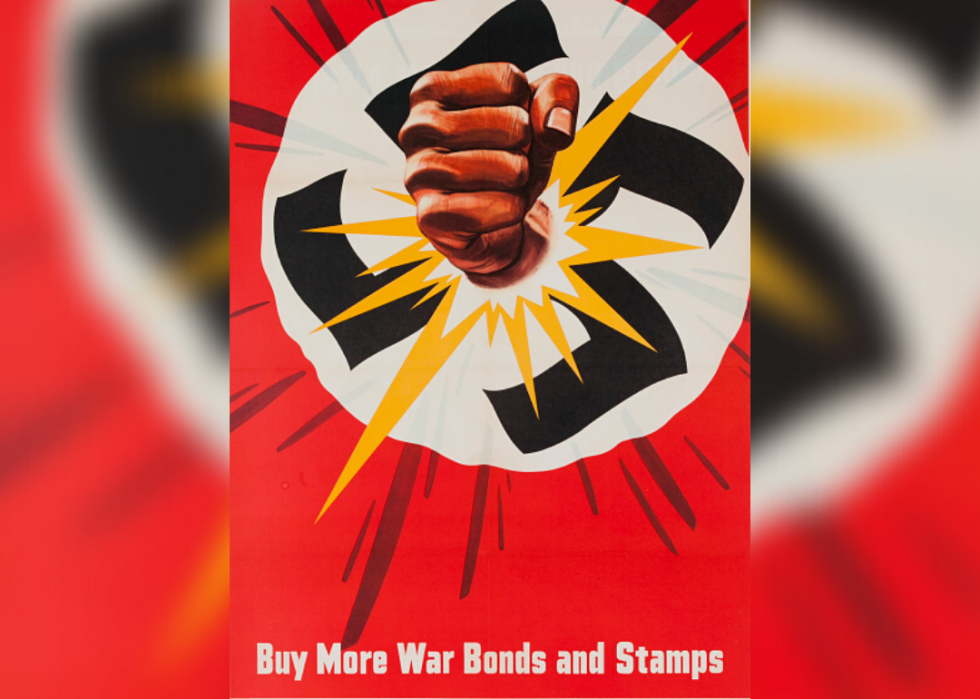
1 / xxx
David Pollack/Corbis // Getty Images
'Buy More War Bonds and Stamps'
In this poster, circa 1942, a powerful fist punches through the image of a swastika, urging Americans to "buy more than war bonds and stamps." The United states of america issued war bonds and stamps to help finance the state of war effort.
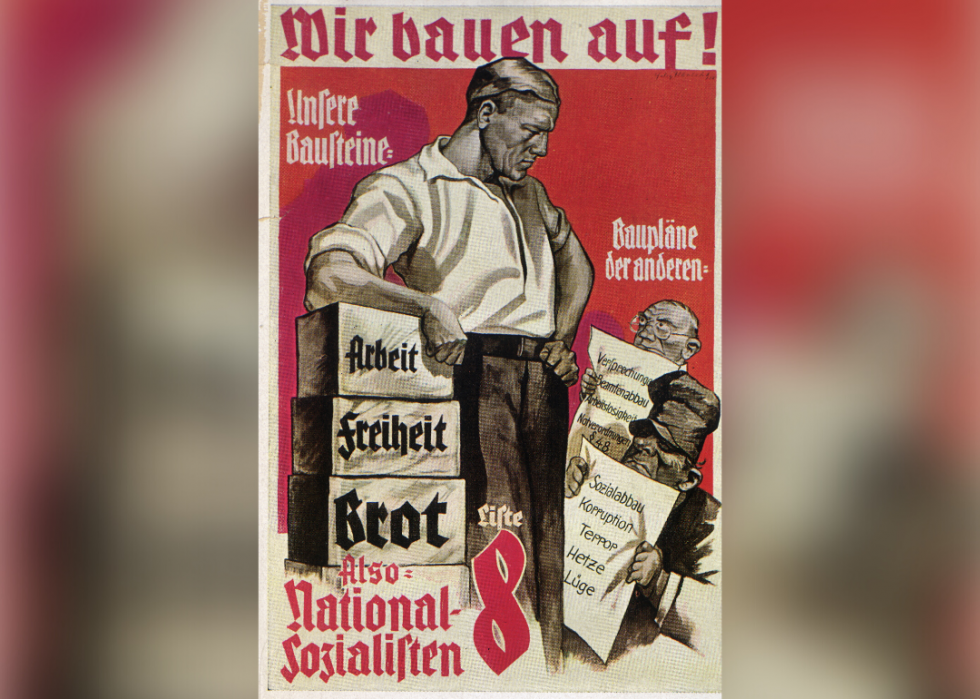
2 / 30
Hulton Archive // Getty Images
'We're Edifice Things Up!'
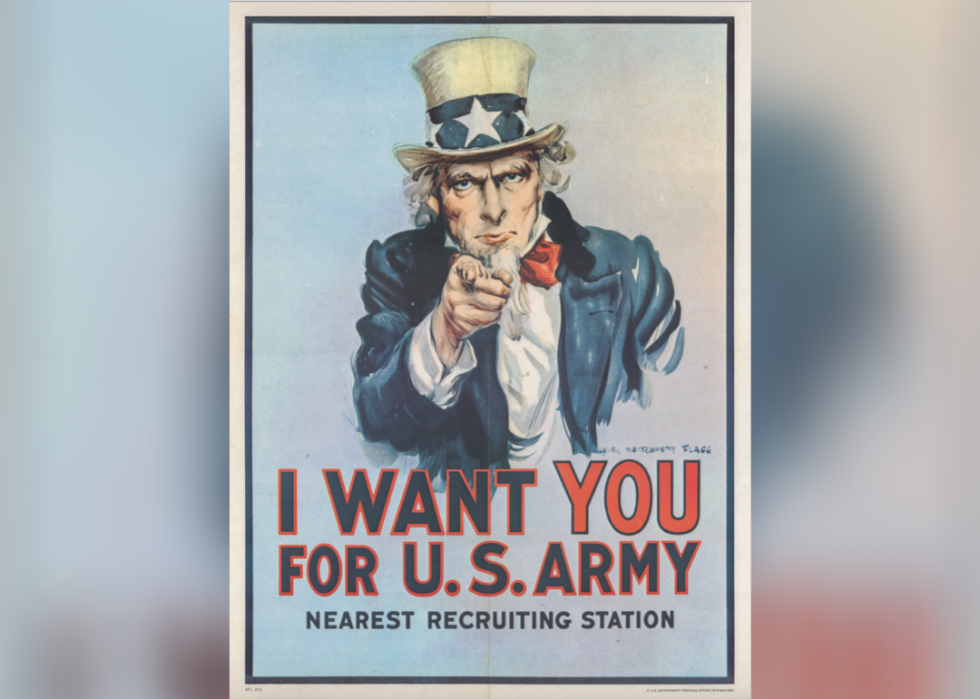
iii / 30
'I Desire You'
Ane of the most lasting and iconic symbols of U.S. patriotism is Uncle Sam, clad in cerise, white, and blue with piercing eyes and a pointing finger in this recruitment poster. James Montgomery Flagg, a magazine illustrator, used himself as the model. Offset produced in Globe War I, the poster was adjusted for use in Globe State of war 2.
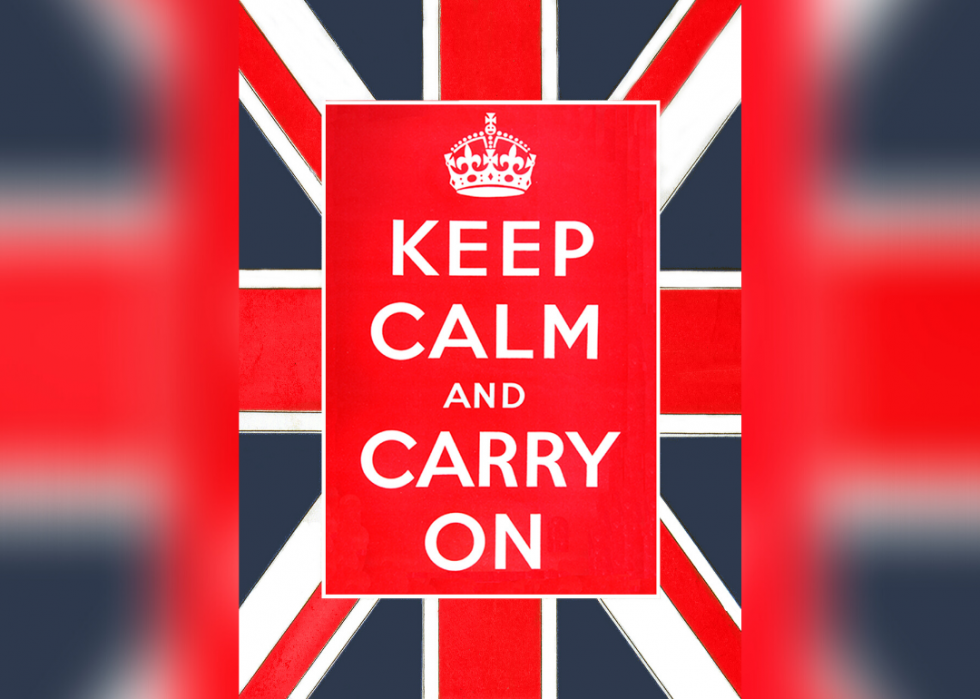
4 / 30
SSPL/National Athenaeum // Getty Images
'Keep Calm and Carry On'
The slogan "Go along Calm and Carry On" was printed on posters by the British government to be distributed in the effect of a German invasion. As that did not happen, the poster was never officially used in public, and following the war, copies were believed to have been destroyed in the National Salvage Campaign recycling effort. Decades later, a handful of the posters were found. Today, the saying is the basis of popular memes, from humorous to political.
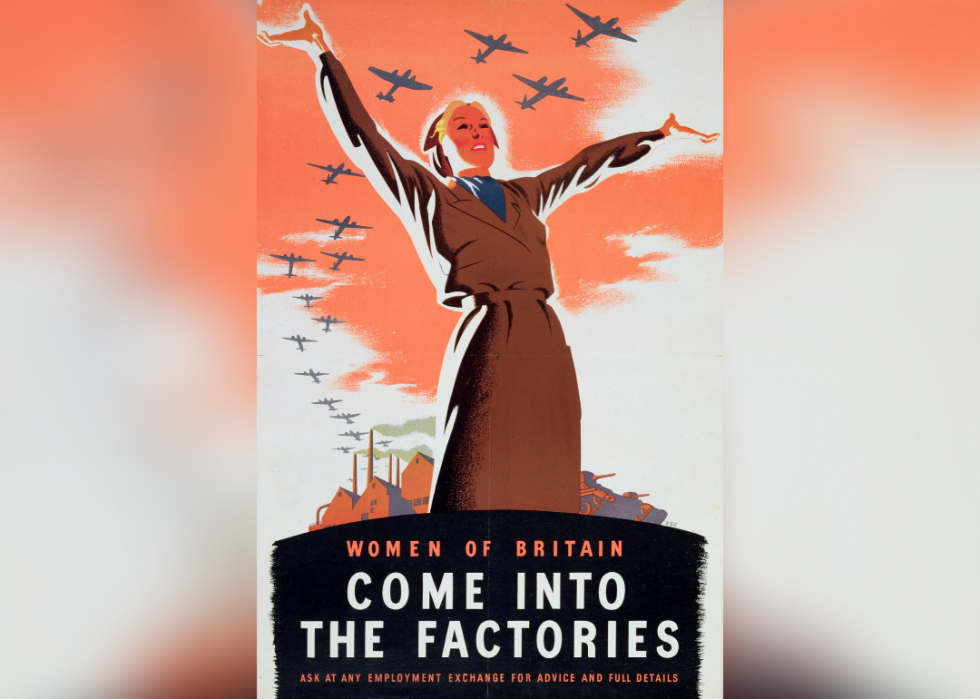
5 / 30
Historica Graphica Collection/Heritage Images // Getty Images
'Come into the Factories'
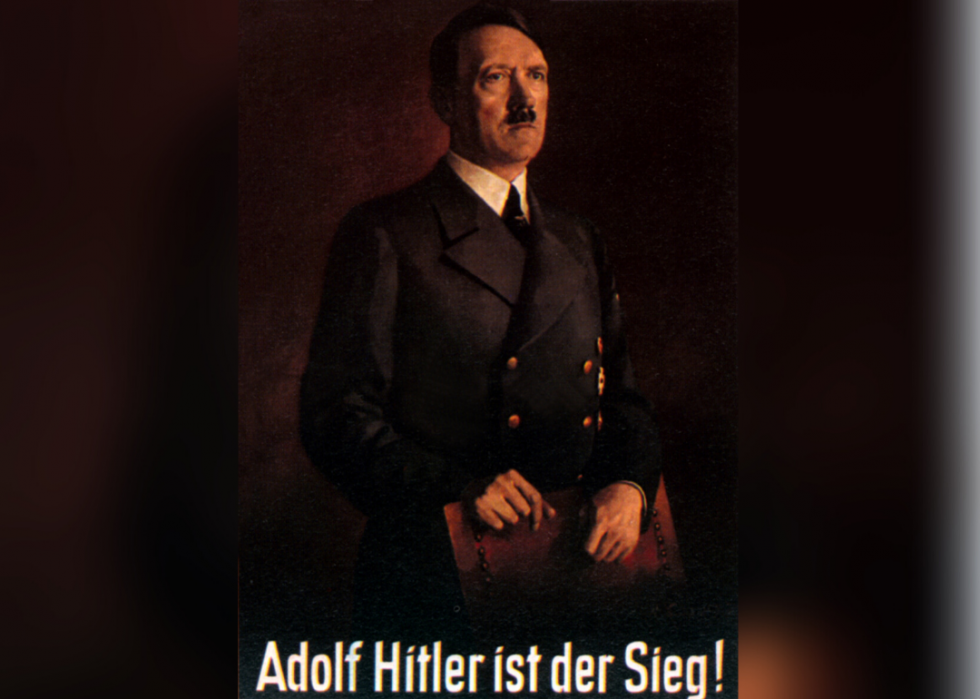
6 / thirty
Galerie Bilderwelt //Getty Images
'Adolf Hitler ist der Sieg!'
This German poster of the Nazi leader posed behind a chair declares, "Adolf Hitler is victory." The portrait was created by German artist Rudolf Gerhard Zill.
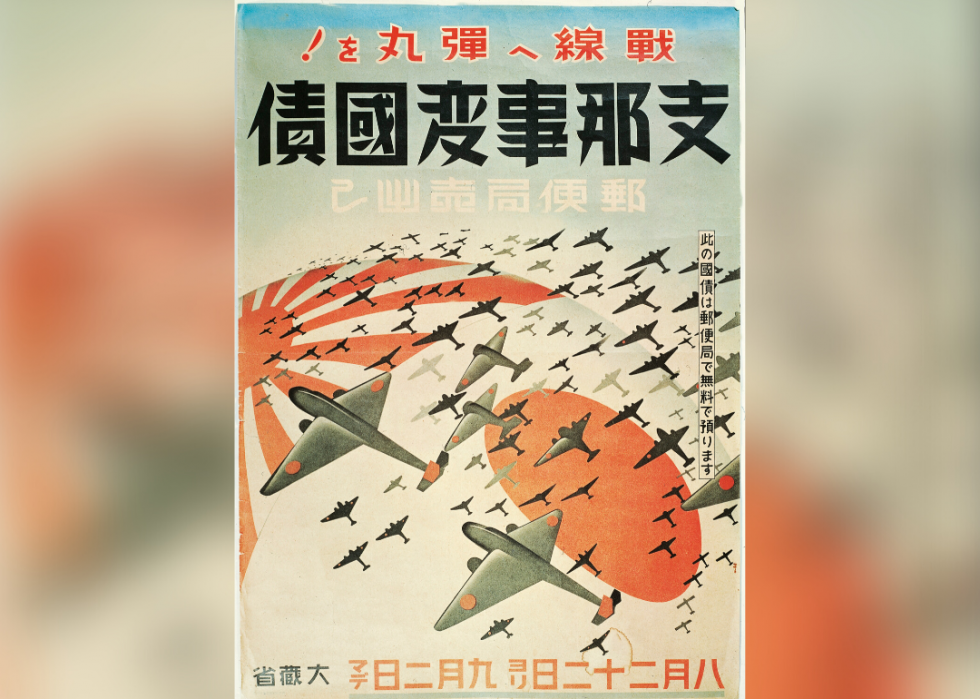
seven / thirty
DeAgostini // Getty Images
Japanese air strength affiche
Japanese war propaganda posters sought to glorify the nation'south military might. This affiche of the Regal Air Force shows countless airplanes flying over a world decorated with Nihon's historic dominicus symbols.
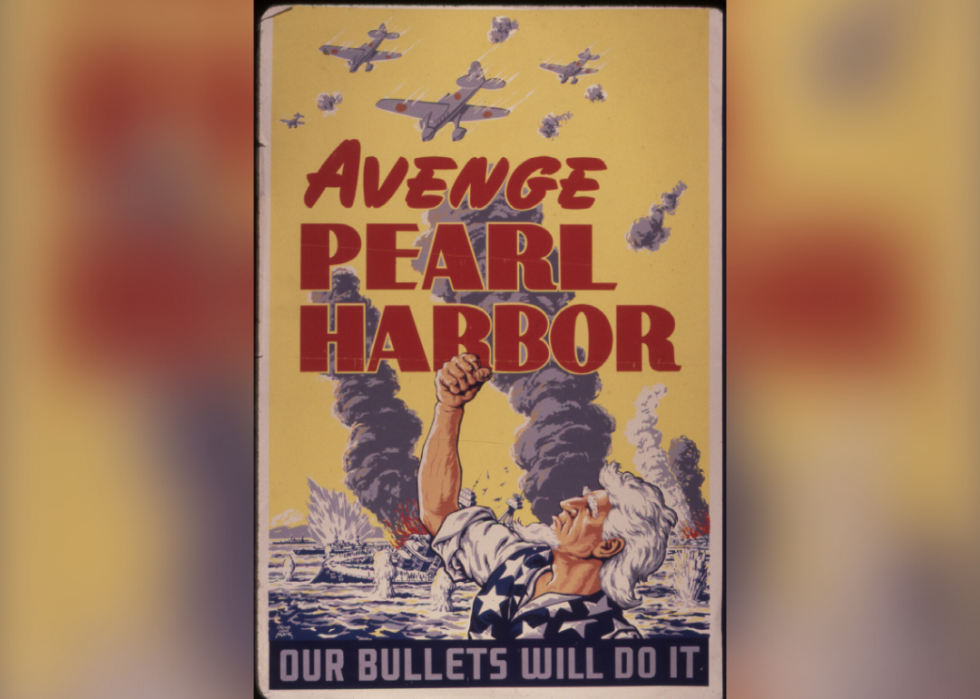
8 / xxx
Smith Collection/Gado/Getty Images).
'Avenge Pearl Harbor'
This dramatic call to arms asks Americans to take activity following the Japanese attack on the U.S. Navy on December 7, 1941. With Uncle Sam raising his fist at warplanes overhead, the appeal marked a primal moment in the state of war when Americans became motivated to spurn isolationism and bring together the cause.
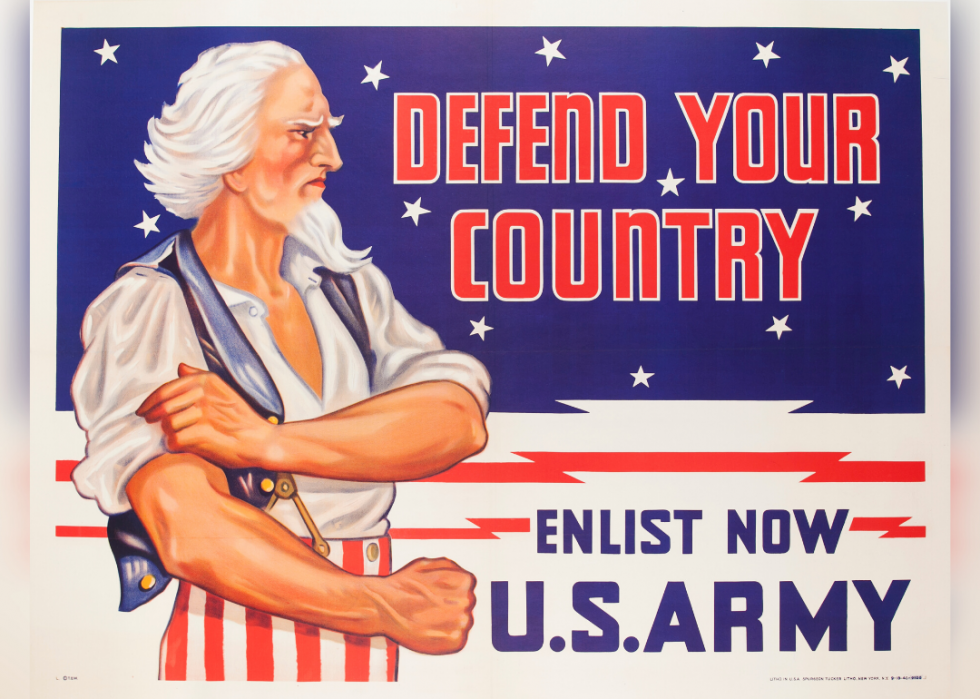
nine / 30
David Pollack/Corbis // Getty Images
'Defend Your Country'
Uncle Sam is rolling up his sleeves, flexing his muscles, and clenching his fist in this U.S. Army "Defend Your Land" recruitment affiche. Uncomplicated and bright, it presents a sense of confidence and forcefulness.
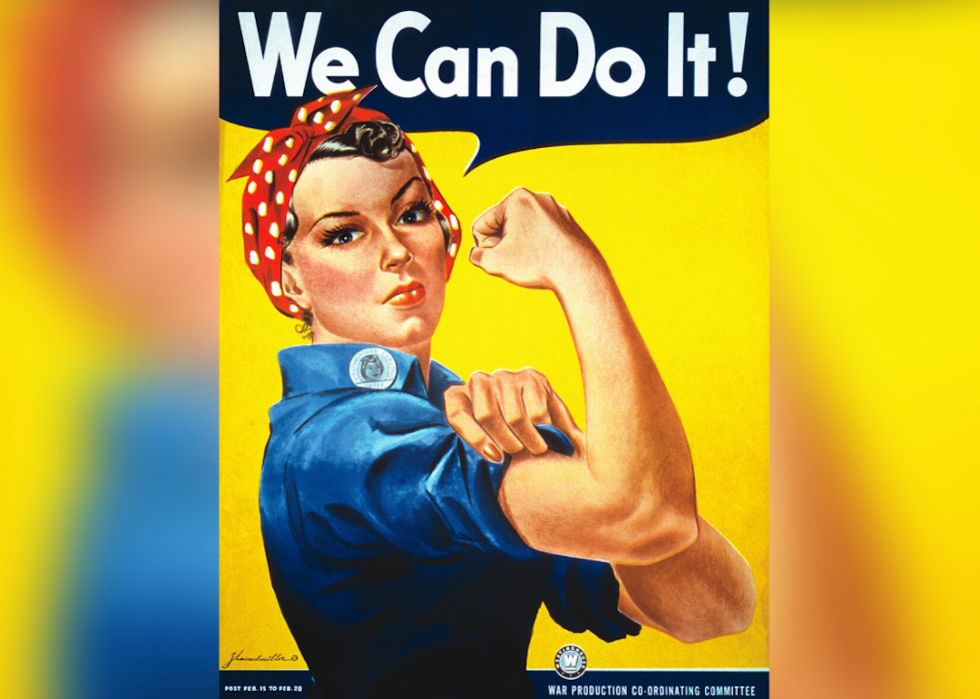
x / thirty
National Archives // Getty Images
'Nosotros Tin Exercise Information technology'
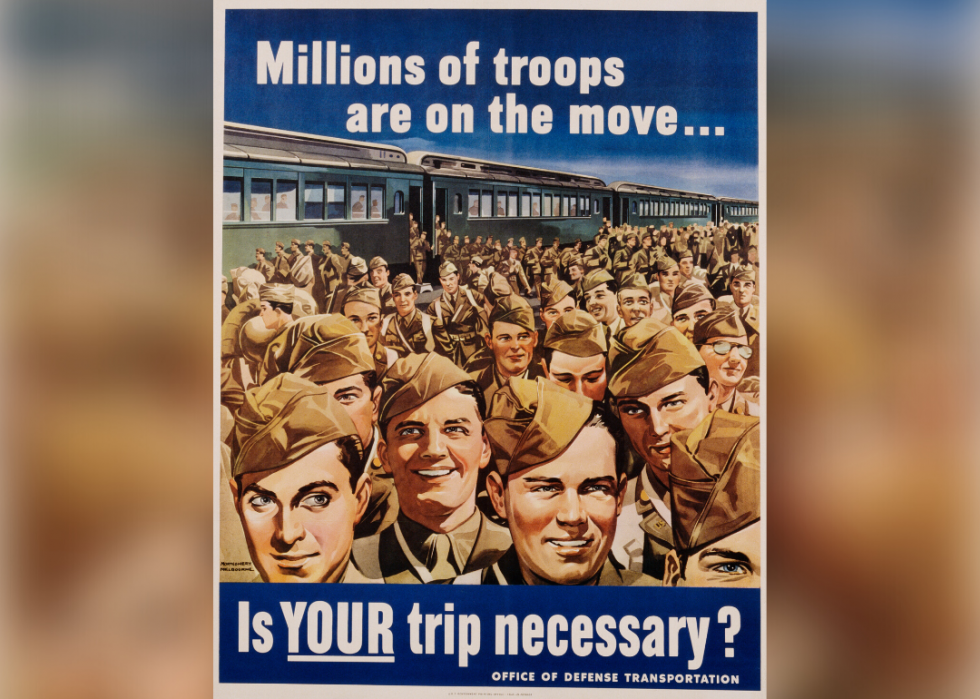
11 / 30
Swim Ink 2, LLC/CORBIS/Corbis // Getty Images
'Is YOUR Trip Necessary?'
The "Is YOUR Trip Necessary?" affiche of the bright-eyed, eager faces of troops gathered in front of a railroad train was used by the U.Southward. government'due south Office of Defense Transportation to remind civilians that the railroad was needed in the war effort. Past 1943, the government restricted leisure use of automobiles and busses to conserve fuel and rubber, leaving just trains for traveling long distances. Commercial artist Montgomery Melbourne, who made the image, is credited with designing advertising images for Kool cigarettes, Morton Salt, and Wrigley'southward Spearmint Gum.
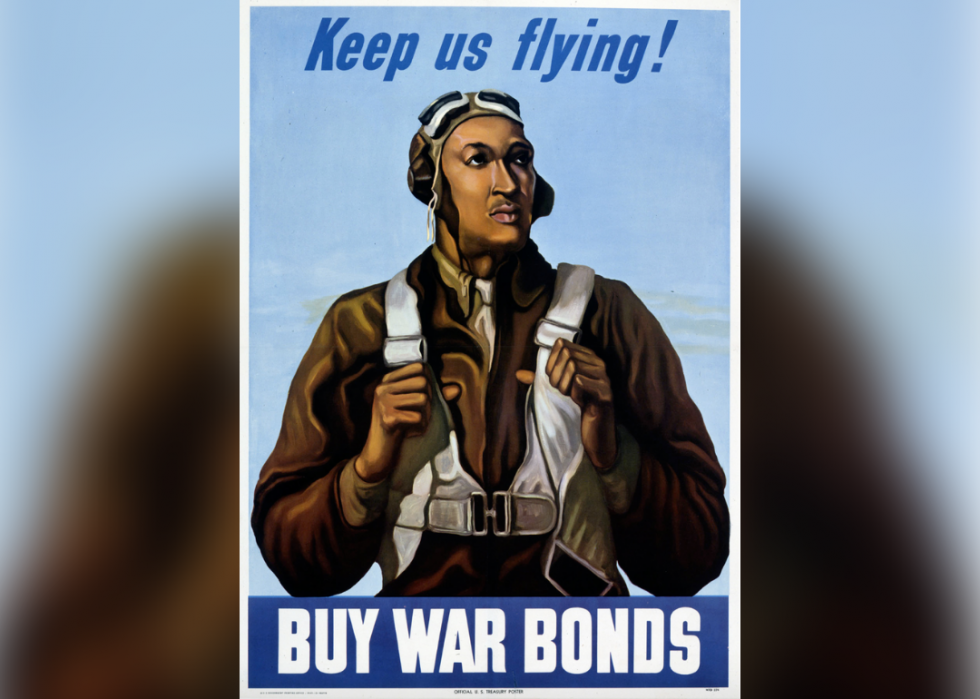
12 / 30
U.South. National Archives // Wikimedia Commons
'Keep Us Flight!'
"Keep Us Flying! Buy War Bonds" by an unidentified artist portrays Lt. Robert Due west. Dietz, a Tuskegee Airman. Blackness men who registered for the draft served in segregated units like the Tuskegee Airmen of the U.S. Army Air Corps. It was highly decorated for bravery and distinguished service.
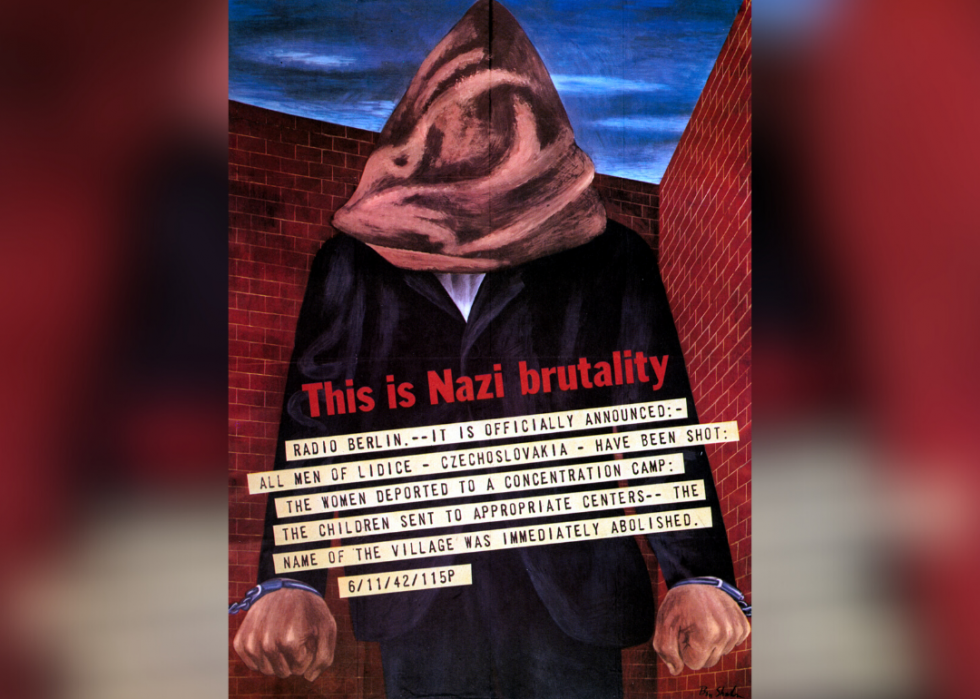
thirteen / xxx
Galerie Bilderwelt // Getty Images
'This is Nazi Brutality'
The U.S. poster "This is Nazi Brutality," showing a hooded prisoner in bondage, tells the story of the Czech village of Lidice, where all the men were shot and the women and children sent to camps in retaliation for the assassination of SS officer Reinhard Heydrich. Initial German intelligence indicated the villagers had helped the resistance, but eventually, in that location was no evidence they were involved. The poster was created past Lithuanian-born American artist Ben Shahn, known for his portrayals of social and political topics.
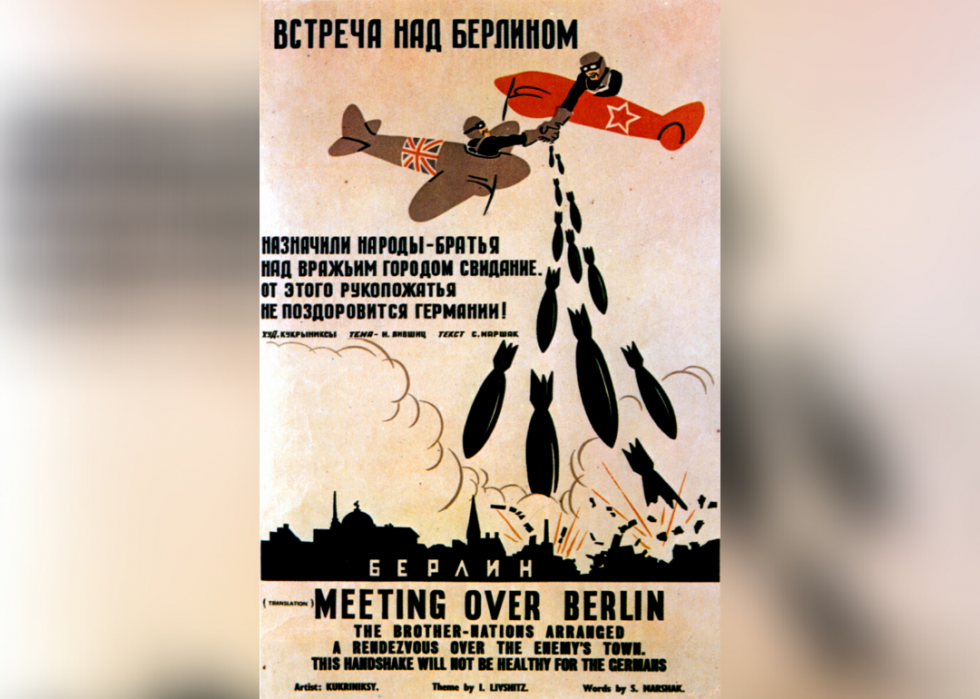
15 / xxx
Galerie Bilderwelt // Getty Images
'Coming together over Berlin'
Celebrating the alliance of the Soviet Spousal relationship and Great United kingdom of great britain and northern ireland, pilots from each nation milk shake hands from their cockpits every bit they drop bombs over Berlin in this "Meeting over Berlin" propaganda poster that declares, "This handshake will not be healthy for the Germans."
The poster was created past Kukryniksy, the proper noun used by three artists—Porfirii Nikitich Krylov, Mikhail Vasil'evich Kupriianov, and Nikolai Aleksandrovich Sokolov—who collaborated for many years on cartoons, book illustrations, and poster designs. Their work was widely published and honored by the Soviet government.
Y'all may too like: Least obedient dog breeds
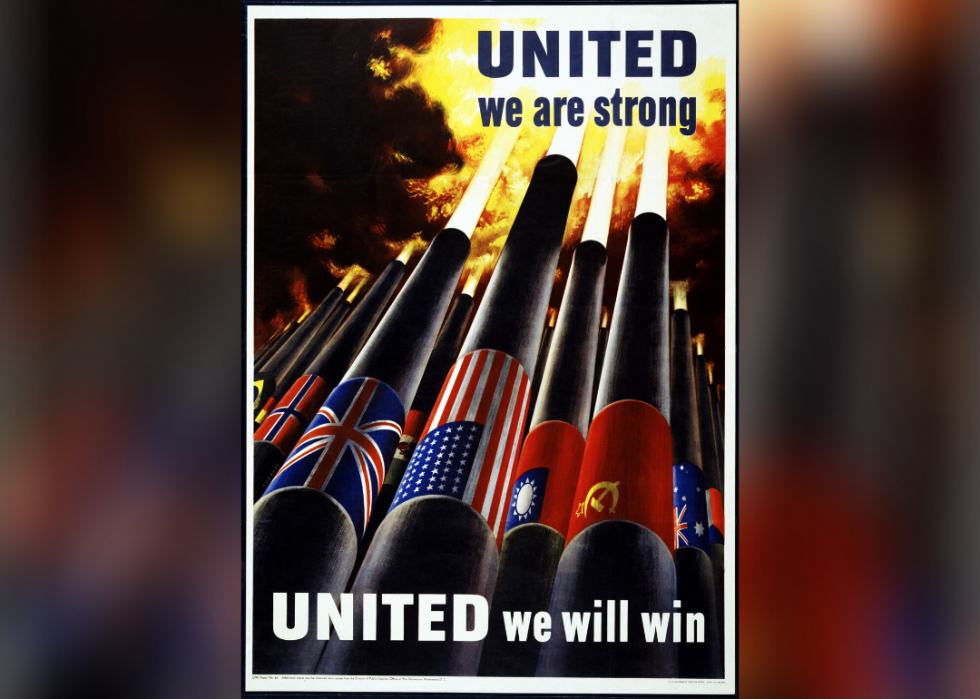
16 / 30
Galerie Bilderwelt // Getty Images
'UNITED we are strong'
Glorifying the power of Allied forces, flags from each of the Allied nations are wrapped around the powerful cannons in the affiche expressing, "United we are stiff. United we will win." Creative person Henry Koerner fled Nazi persecution of the Jews and immigrated to the United States from Vienna in 1938. He returned to Europe equally a U.S. soldier and learned that his family had been deported and died.
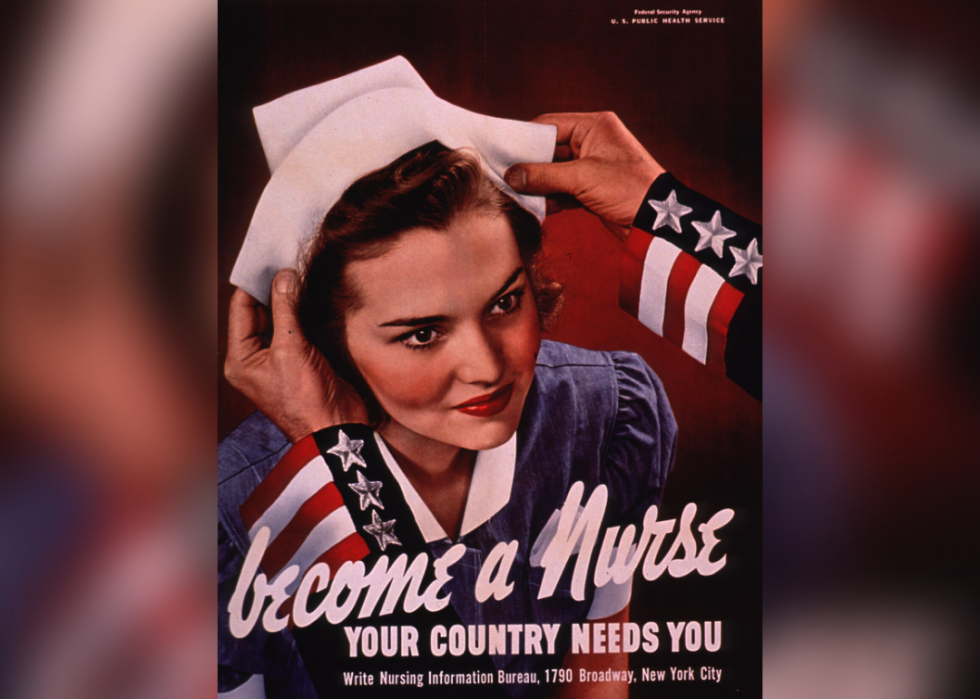
17 / 30
Smith Collection/Gado // Getty Images
'Get a Nurse'
The "Become a Nurse" poster was produced by the U.Due south. Public Health Service to encourage women to become armed forces nurses. The nation had a shortage of nurses during the state of war, and in 1943, Congress established the Buck Nurse Corps. Nigh 120,000 women trained with the Corps and served in military hospitals and other facilities.
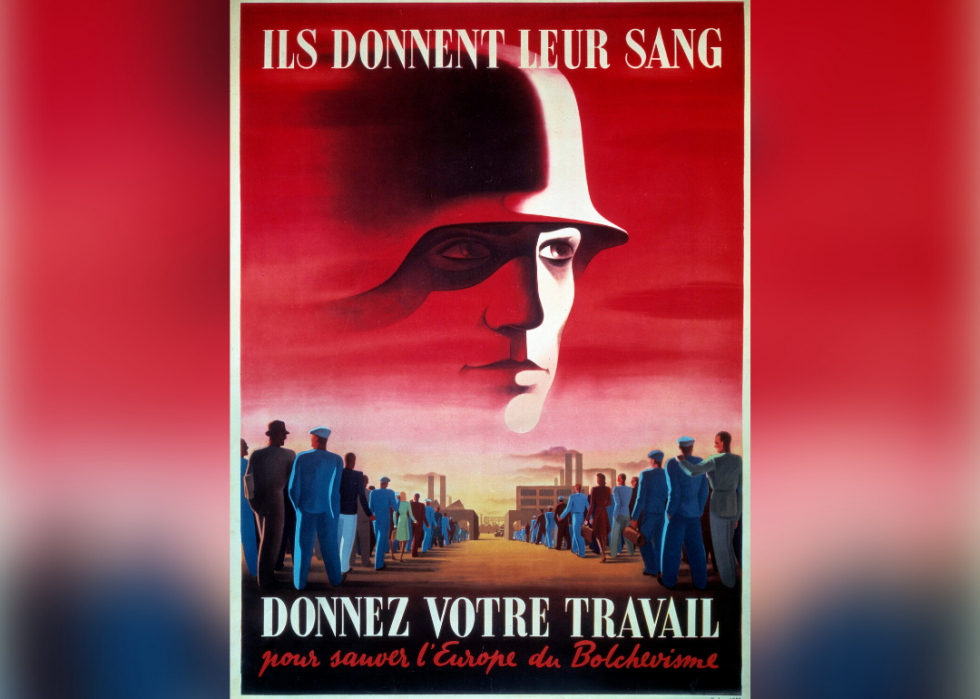
eighteen / thirty
Leemage/Corbis // Getty Images
'They Give Blood'
This German language and Vichy French propaganda affiche urged citizens to join the Service du Travail Obligatoire (STO) or Compulsory Work Service. It depicts lines of workers filing into factories under the image of a helmeted soldier and the words: "They requite blood, give your work to save Europe from Bolshevism." The STO required workers in collaborationist France to provide two years of service, and they were put to work in Germany, French republic, Austria, Poland, and Czechoslovakia.
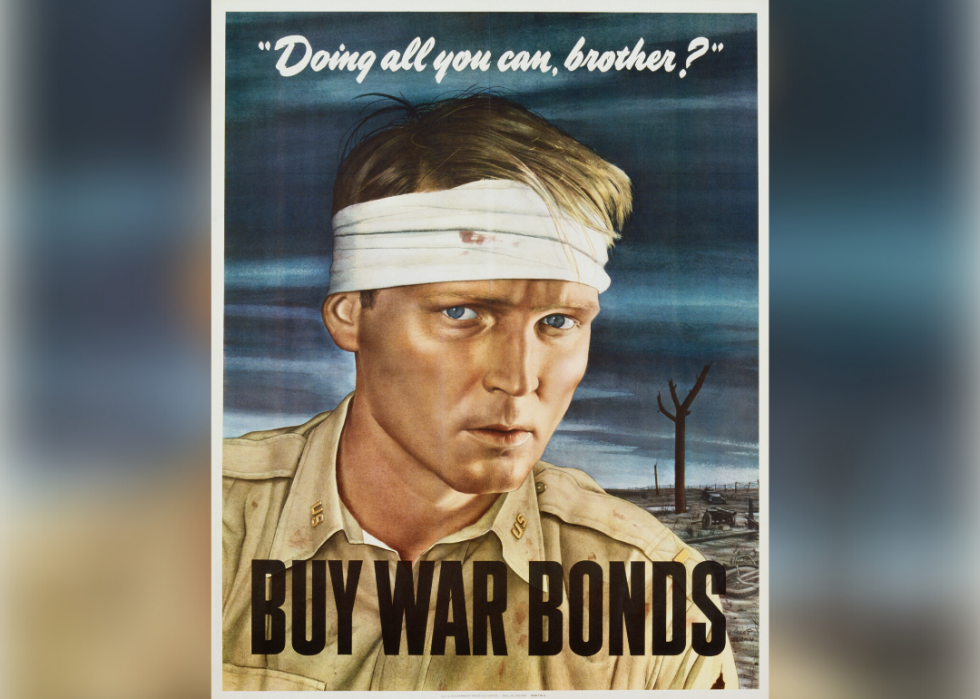
19 / thirty
Swim Ink ii, LLC/CORBIS/Corbis // Getty Images
'Doing all y'all can, brother?'
A handsome blond, blue-eyed soldier, his head wrapped in a bloody bandage, asks, "Doing all you tin can, blood brother?" in this U.Due south. authorities poster ad state of war bonds. During Earth War II, Americans bought more than $185 billion worth of war bonds that came in denominations equally modest as $25, were sold at a disbelieve, and matured in 10 years. Commercial illustrator Robert Sloan was commissioned by the government to create the poster and given a Commendation for Distinguished Service for the work.
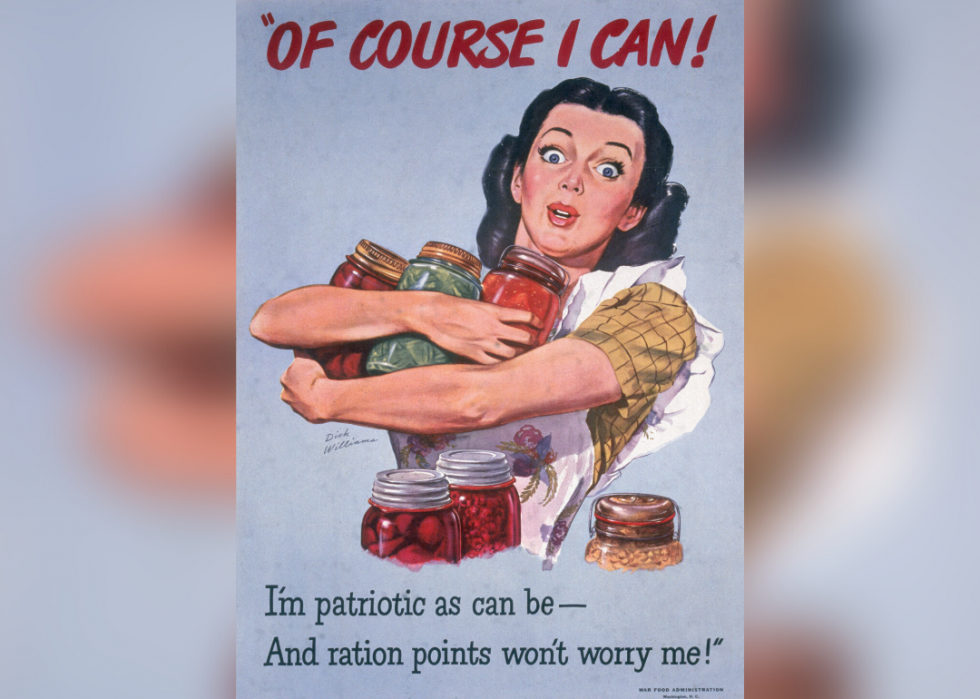
twenty / xxx
Hulton Annal // Getty Images
'Of Course I Tin can!'
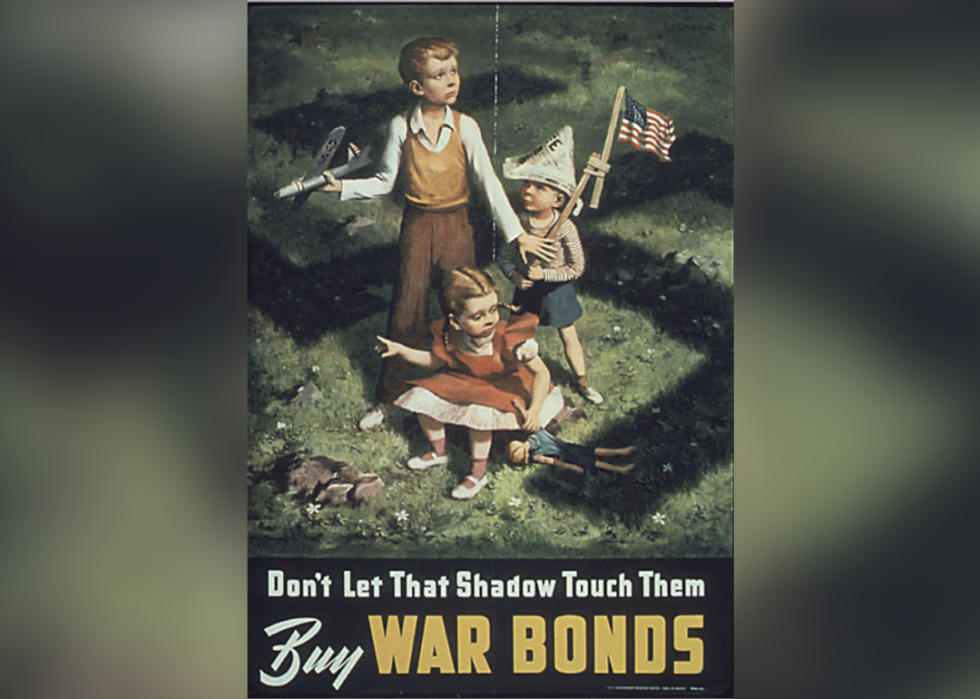
21 / xxx
'Don't Let That Shadow Touch Them'
The ominous shadow of a Nazi swastika darkens this poster of three children playing with a doll, a toy airplane, and a makeshift American flag. The depiction of their innocence was used in the exhortation to help fund the war effort by purchasing war bonds, with the message: "Don't let that shadow impact them." Creator Lawrence Beall Smith served every bit a combat creative person who traveled on U.S. armed forces aircraft carriers in the Mediterranean and witnessed the D-Solar day landings in Normandy, France, in 1944.
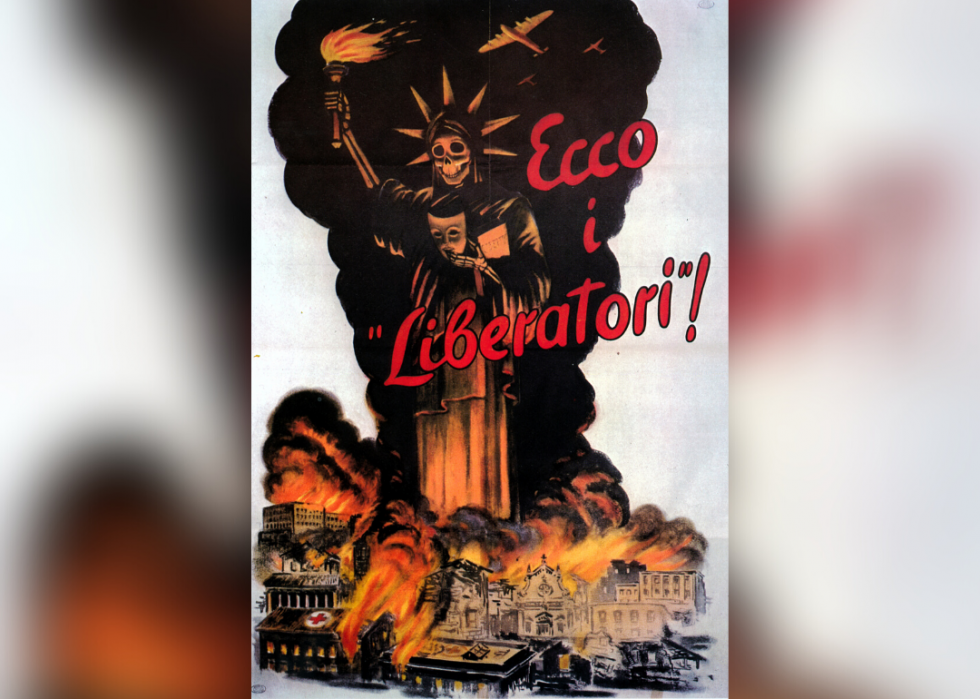
22 / 30
Galerie Bilderwelt //Getty Images
'Ecco i Liberatori'
In this Italian affiche, America's Statue of Liberty, with the confront of a grin skull, presides over destroyed buildings in flames. The phrase "Ecco i Liberatori!" or "Hither are the liberators!" was a comment on the barbarity of U.S. forces by the Italian authorities.
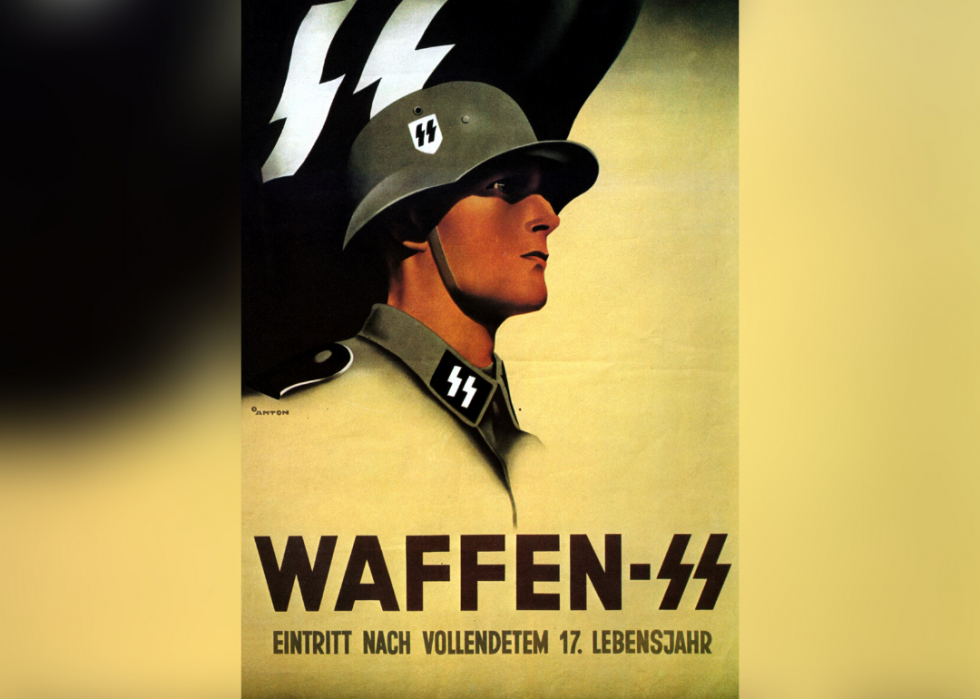
23 / thirty
Hulton Archive // Getty Images
'Waffen-SS'
This German recruitment poster portrays a helmeted soldier in profile, staring into the distance, with the words "Waffen-SS" and "Eintritt Nach Vollendetem 17 Lebensjahr," meaning recruits must be at to the lowest degree 17 years former. The Waffen-SS was the military machine arm of the feared SS elite security strength in Nazi Germany and included Adolf Hitler'due south bodyguards and battalions that ran concentration camps.
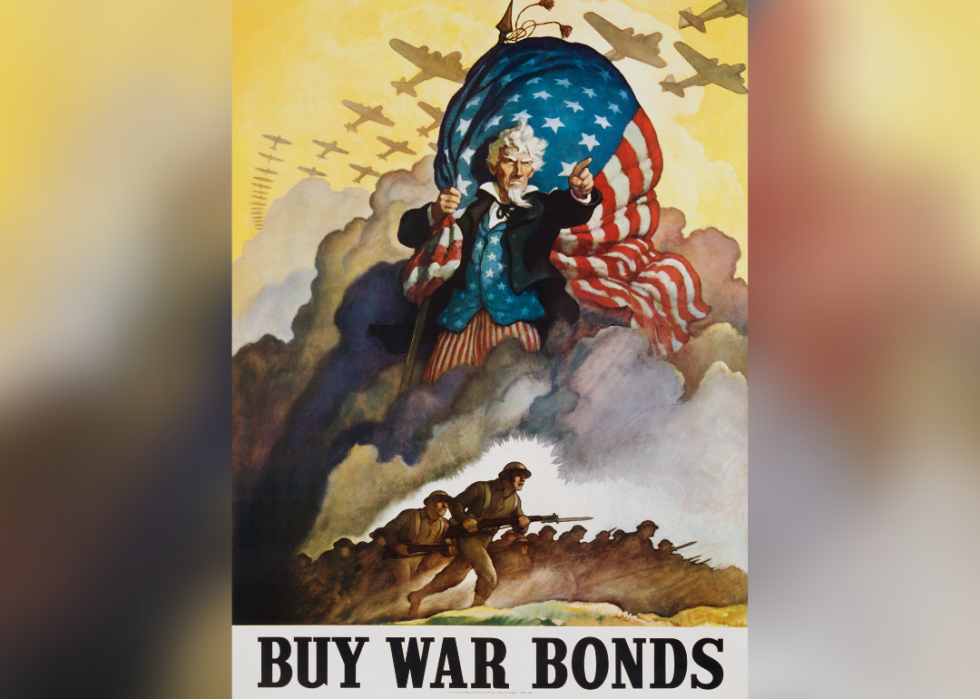
24 / 30
Swim Ink 2, LLC/CORBIS/Corbis // Getty Images
'Buy War Bonds'
Looking more like a watercolor painting than propaganda, the "Buy War Bonds" poster shows a flag-begetting Uncle Sam in the clouds, directing troops brandishing bayonets. The godly image conveys a sense of the divine virtue of the Centrolineal effort against Axis forces.
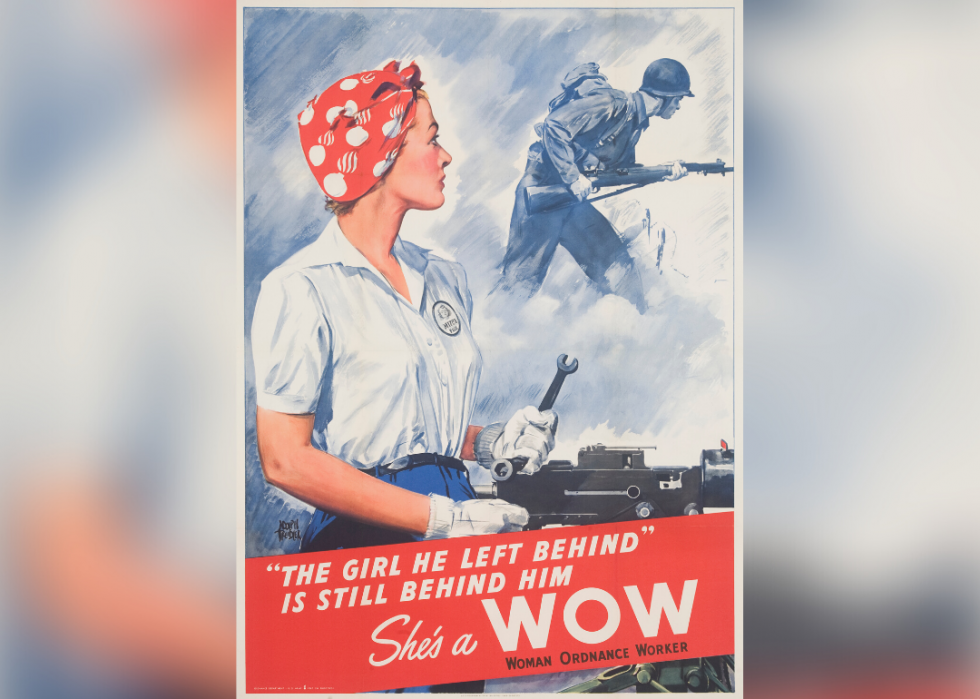
25 / 30
David Pollack/Corbis // Getty Images
'She'due south a WOW'
American illustrator Adolph Treidler created several posters during World War Two celebrating Women Ordnance Workers (WOWs), who made military materials such as weapons and munitions. The motivational poster shows a beautiful woman tackling a traditionally male person job with the line, "She's a WOW."
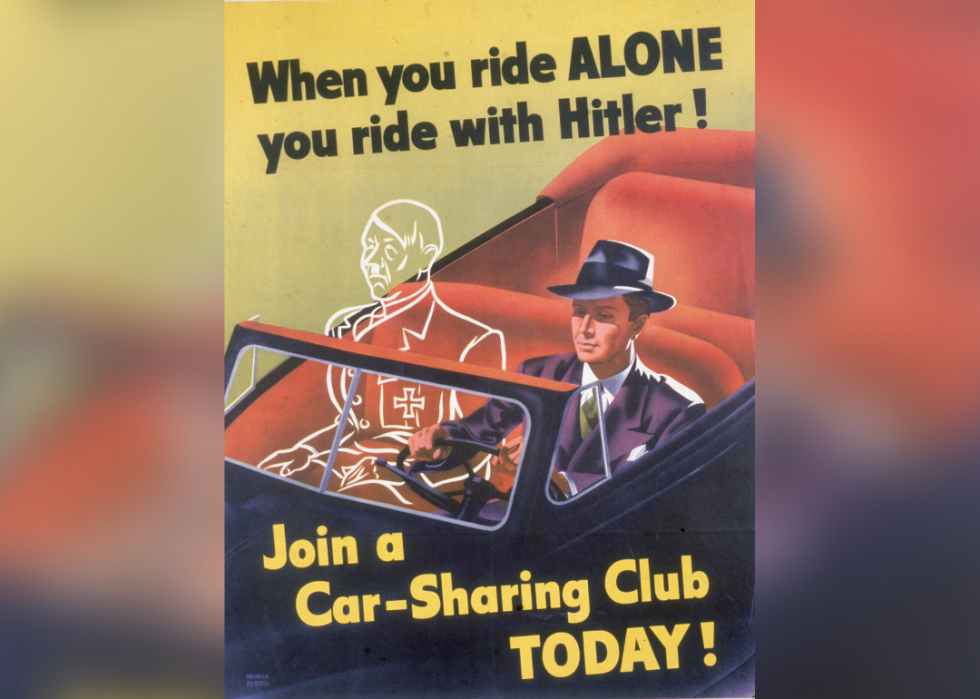
26 / xxx
Hulton Athenaeum // Getty Images
'When You Ride Lonely, You Ride with Hitler!'
The "When You Ride Lonely, You Ride with Hitler!" poster calls upon Americans to carpool and conserve fuel for armed services utilize. It was created past American artist Weimer Pursell, who designed well-known ad for Coca-Cola, American Airlines, Winchester Rifles, and the 1933 Chicago World's Fair.
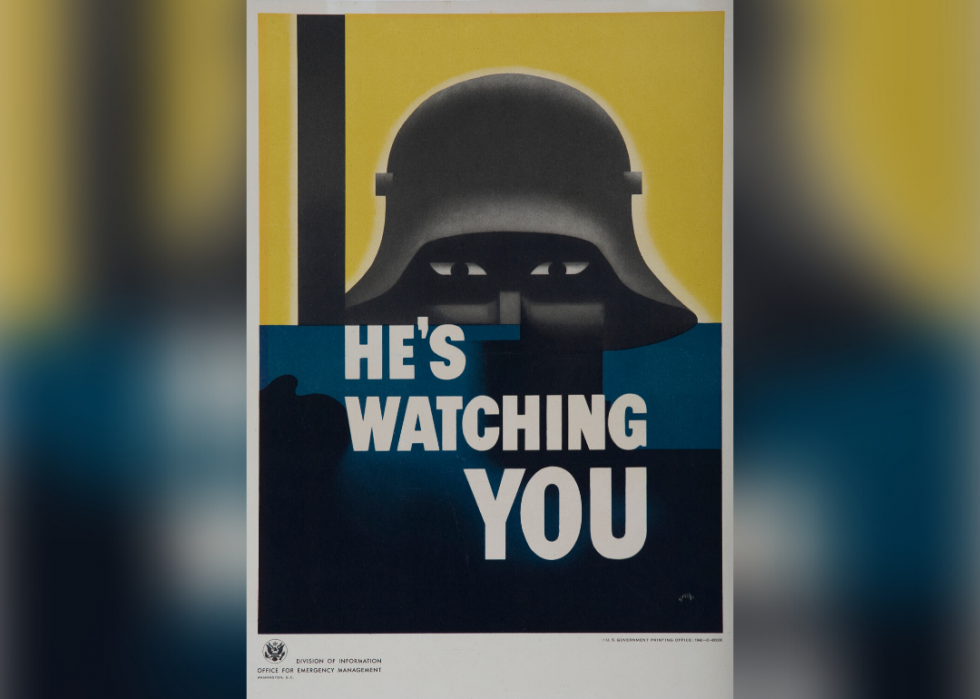
27 / 30
David Pollack/Corbis // Getty Images
'He's Watching You lot'
The menacing optics of a helmeted enemy soldier dominate this U.South. authorities poster that reads, "He'due south watching you," cautioning Americans that spies could lurk anywhere. A survey of the public by the regime's Office of Facts and Figures in 1942 determined many viewers misinterpreted the poster, with some mistaking the German helmet for the Freedom Bong. The Part of State of war Information was created later that year to oversee affiche product and command messaging.
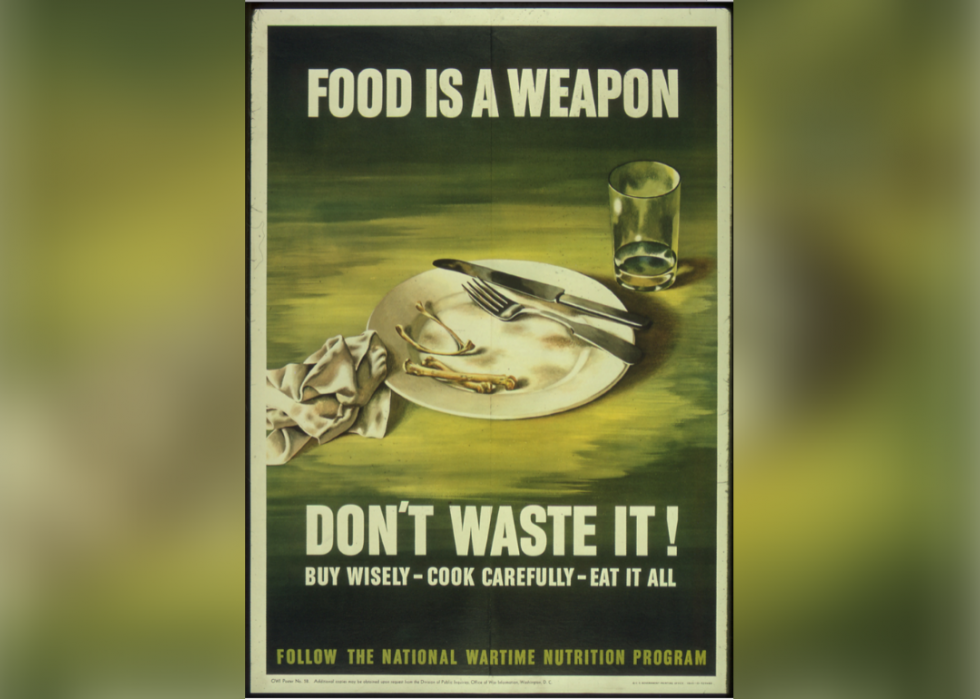
28 / thirty
'Food Is a Weapon'
The U.S. Office of State of war Information'due south "Nutrient is a Weapon" poster was part of a campaign to trim food waste amid shortages and rationing. The admonition to "swallow it all" also reminded Americans of the demand to stay good for you and strong equally the state of war raged.
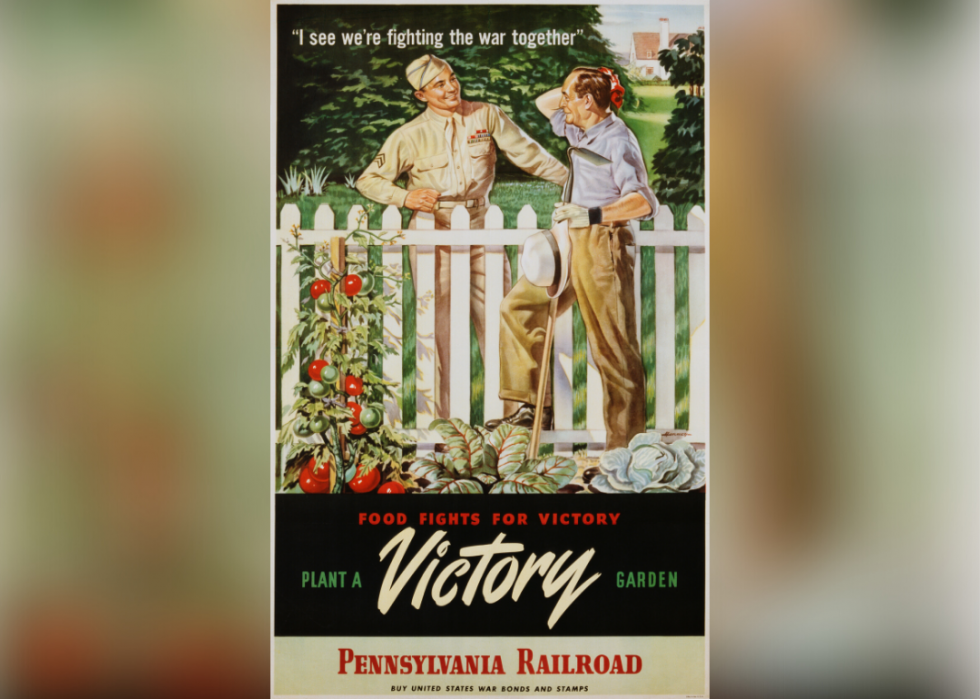
29 / 30
Swim Ink 2, LLC/CORBIS/Corbis // Getty Images
'Plant a Victory Garden'
"Institute a Victory Garden" shows a soldier and a gardener chatting over a white sentry fence with the words "I meet we're fighting the war together." Americans grew their own vegetables and fruits in victory gardens as commercial crops and transportation were taken up by the state of war endeavor, and food rationing was imposed. The victory garden entrada was employed to remind Americans they could pitch in and show patriotism in their own chiliad. Former First Lady Eleanor Roosevelt planted a victory garden of her ain on the lawn of the White House.
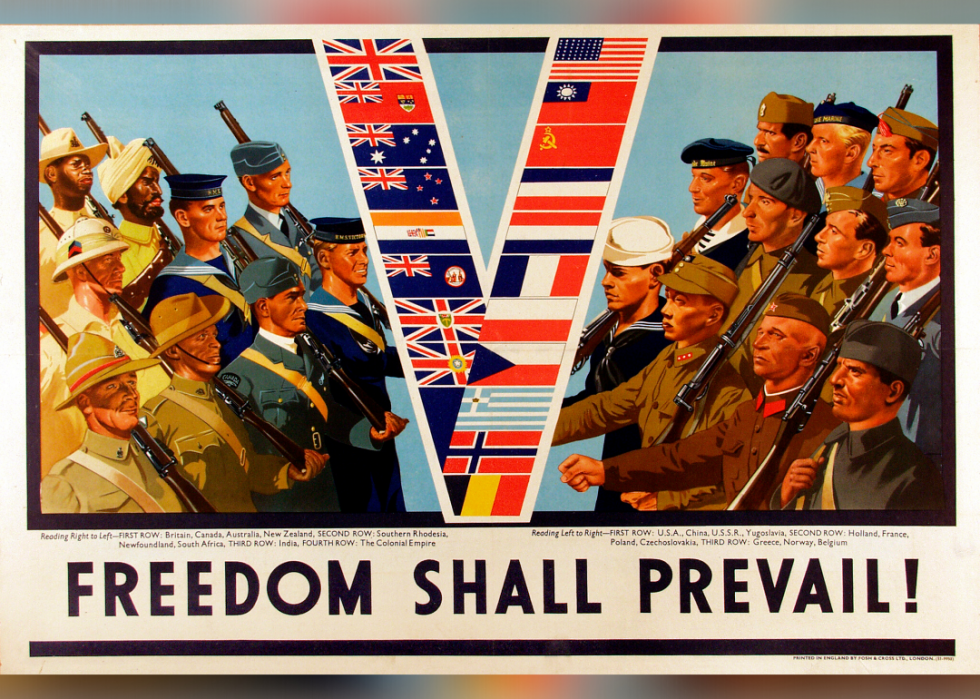
30 / thirty
Fotosearch // Getty Images
'Liberty Shall Prevail'
The "Freedom Shall Prevail" poster shows uniformed soldiers from Allied countries, their flags forming a "5" for victory. The poster reminds viewers of the far-flung members of the Allied front, such equally New Zealand, Southern Rhodesia, and Due south Africa. It was a creation of William Little, an artist commissioned by Slap-up United kingdom's Ministry building of Information during World War II.
You lot may also like: Origins of the 50 most popular domestic dog breeds
Trending Now
© Stacker 2022. All rights reserved.
Source: https://stacker.com/stories/3949/30-iconic-posters-world-war-ii
0 Response to "German Wwii Planes Usa Drawing Easy"
Post a Comment